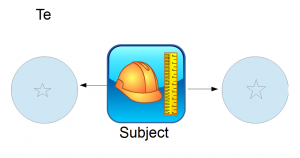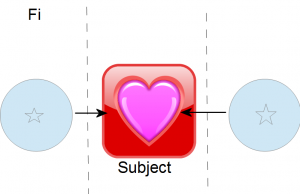Boye Akinwande is a contributing guest writer for CelebrityTypes. As always with guest writers on the site, Akinwande’s own insights and assessments are his own and not necessarily the same as those of the site. In this article, Akinwande elaborates on the concept of function axes and how to illustrate their opposition, mirroring, and tension.
By Boye Akinwande
For a long time, I have wanted to provide a few simple diagrams that illustrate my understanding of the mirroring and tension that takes place between the two functions on each function axis. While I am aware that the functions are far more complex than they appear in my diagrams, my intention is to make the axial relation of each function easier to digest.
Te/Fi
As I’ve said in my article Determining Function Axes Part 3, Te/Fi types are more prone to stress the differences between individuals than those things that unite them. They thus tend to perceive the interests of others as naturally diverging from their own. If two people reach an impasse because each wants something different, this need not be due to a lack of fellow-feeling or cooperation: This is simply the way things are.
In my diagram illustrating this function axis, people are here represented by the circles. Each circle is very much its own entity, and thus its own person, but the flow emanating from each of the two functions runs in different directions.
Te
 In the Te mode, the cognitive energy pours out from the subject and spills onto external objects. In my diagram, the arrows represent this assault on outer objects, as they are subjugated to the Te type’s factual matrix of objective facts and data. By seizing the objects where they have no choice but to be seized – that is, on account of their rational and objective aspects – the Te type manages to secure their desired outcome from an uncooperative and deviant world.
In the Te mode, the cognitive energy pours out from the subject and spills onto external objects. In my diagram, the arrows represent this assault on outer objects, as they are subjugated to the Te type’s factual matrix of objective facts and data. By seizing the objects where they have no choice but to be seized – that is, on account of their rational and objective aspects – the Te type manages to secure their desired outcome from an uncooperative and deviant world.
Fi
Conversely, in my diagram representing Fi, the arrows representing the movement of psychic energy flow inwards, from outer objects and into the subject, symbolizing the development of personal passions and ideals. Ideals that, while abstract, are nevertheless evoked by and derived from specific external objects and the Fi type’s relation to  them and subjective appreciation of their individuality.
them and subjective appreciation of their individuality.
The Te/Fi Axis
Taken together, these two diagrams illustrate some of the typical cognitive biases of Te/Fi types (that is, of TJ and FP types). For example, with TJ types one can often see their eagerness and how they are attuned to applying external and objective laws to their environment in order to dictate what can take place there. But on the other side of the axis, TJ types may also have difficulty forming ideals or experiencing passions independently of the external regimens that they force on outer objects.
Since Fi types lie at the other end of the axis, their psychic life is more attuned to forming judgments that, while indirectly inspired by other objects, can nevertheless run counter to what their current empirical properties would suggest was practical or practicable. With the Fi type reacting to the impressions of objects in their own subjective way, they can be allowed to follow their own subjective passions in a sympathetic fashion that exists in a parallel dimension from what is actually possible. In my Fi diagram, this “sympathetic parallelism” is denoted by the dotted lines, which represent the tendency of Fi judgments to shield themselves from the ‘compulsory’ or ‘objective’ properties of external objects. Because of this inclination, FP types may sometimes refuse to deal with even the most obvious of logical trade-offs, so as not to pollute the purity of their inner world or compromise their ideals.

You guys still do typings on this site?
Yes.
‘cognitive energy pours out from the subject and spills onto external objects’
What the actual ****?!
If only your words spilled from your brain through your mouth instead of from your gut downward !
IDR Admins, take this down will ya. It’s ruining the rest of your site.